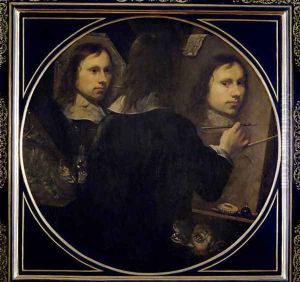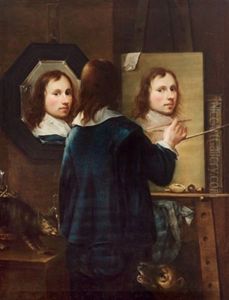Johannes Gumpp Paintings
Johannes Gumpp was an Austrian painter born in 1626, known primarily for his self-portrait that showcases a unique approach to depicting the artist's image. The precise details of his death remain unknown, reflecting the limited documentation on many artists of the period outside of their work. Despite the scarcity of records regarding his life and death, Gumpp's contributions to art, particularly his innovative self-portrait, have earned him a place in art history discussions.
Gumpp comes from a family of artists, which likely influenced his early education and inclination towards painting. However, specific details about his training and early career are sparse. What sets Johannes Gumpp apart in art history is his self-portrait from 1646, a remarkable work that shows him from three different perspectives: his actual reflection in a mirror, his back as he sits facing the mirror, and him working on the self-portrait on the canvas within the same painting. This triple self-portrait is not only a technical feat but also a profound exploration of the nature of self-representation and the artist's role in his own work.
Beyond this famous self-portrait, little is known about the breadth of Gumpp's oeuvre. He is often mentioned in discussions of Baroque art, particularly in the context of self-portraiture, a genre that experienced significant development during the Baroque period. Gumpp's innovative approach to self-portraiture contributes to our understanding of the period's artistic explorations and challenges.
Despite the lack of comprehensive records regarding his career and the broader scope of his work, Johannes Gumpp's unique self-portrait continues to captivate art historians and enthusiasts. It serves as a testament to his skill and creative vision, ensuring his place in art history, even in the face of limited biographical details. His work invites ongoing speculation and interpretation about the artist's intentions and the broader implications of his approach to self-representation.

